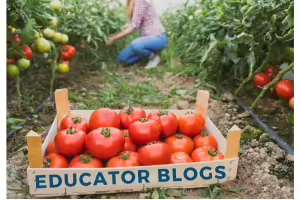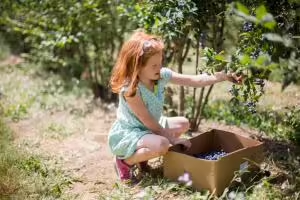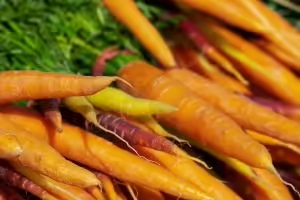Local Foods & Small Farms
Americans have never been more interested in understanding where their food comes from and how it was grown and prepared. From the use of pesticides during the growing season to the practice of composting food waste, there is a lot of information available through Illinois Extension that provides insight into how fruits, vegetables, and food products move through their life cycle. The Local Foods & Small Farms program provides resources to help consumers and producers better understand their role and responsibilities within the local food movement.
Looking for an answer to a specific question? Contact our local foods & small farms educator, Grant McCarty, to learn more about how Illinois Extension is prepared to help.

Read the Blog
Gardening tips and MORE!
Illinois Cottage Food Operations
What is a Cottage Food Operation?
Illinois Agritourism
Resources for businesses that market farm-raised or produced products and outdoor experiences
Local Foods and Small Farms YOUTube Channel
The University of Illinois Extension Local Foods and Small Farms Educators have a YOUTube channel of recorded webinars that are a great resource. Check them out by clicking here!Local information you can use
McCarty has authored a series of concise yet insightful articles aimed at providing expert assistance, resources, and educational opportunities to commercial specialty growers locally. His area of focus is on tree fruits (apples, pears, cherry, peach), small fruits (brambles, blueberries, strawberries), and vegetables. Within these crops, his outreach is in general production, training-pruning, insects-diseases, and soil health. Each year, he consults with nearly 120 specialty growers and farmers at different stages of their farming journey.
June 12, 2024 - Tart cherry season begins in Northern Illinois
While it may seem early, tart cherries are almost ready in backyard and commercial orchards in Northern Illinois. The tart cherry harvest season will begin in the next two weeks, towards the middle and end of June, maybe even sooner.
“June remains an active month for specialty crops. At farms in Jo Daviess and Stephenson counties, we wrap-up rhubarb and asparagus, start strawberry season, and then follow that up with tart cherries” states Grant McCarty, Local Foods and Small Farms Educator, University of Illinois Extension. “We don’t see as many tart cherry u-pick orchards, but you may find them at your local farmers market or certainly in the backyard.”
Like their name denotes, these cherries have a sour quality to them that makes them ideal for baking, cooking, and using in recipes that are combined with sugar. They tend to be very juicy with a good amount of acid in them. These cherries, also called sour, are in the stone fruit family which includes peach, apricot, plum, and others. “Commonly, tart cherries are the only consistent member of this family for growers in Northern Illinois as they can withstand the cold climate each year and you just need one tree for a yearly crop. Sweet cherries can be more difficult to grow in our region as most varieties require more than one variety for cross-pollination.” McCarty continues.
A ripe cherry is ready to be picked if it has the right color, firmness, and comes off the stem easily. Cherries do not ripen further after they have been picked. “You may find that you may want to keep these cherries on the tree a bit longer in order to develop; but if you wait too long, birds may get to them before you can”
July 26, 2024 - Growers preparing for the upcoming u-pick apple season
During the weekend of July 12 to 14 and the week of July 15, we had some farms that received quite a lot of rain and severe winds. Some farms reported receiving 7-8 inches of rain while others, like in the Freeport area, had about 3-4 inches. This was combined with very warm temperatures (above 90 F). The end of the week had us drying out and low temperatures dipping into the 50s and 60 s F.
In the same week, I visited Freeport High School’s (Freeport, IL) Student Vegetable Farm. They run a CSA, farm stand, and attend a weekly farmers market. These students are involved in all aspects of production before and during the growing season. Like other vegetable growers in the region, cool season crops are in peak harvest and warm season crops are right around the corner. Sweet corn season began last week for growers. Insect/disease pressure does look a bit low this year but still varies from farm-to-farm.
In the Rockford region, July marks a month of transitions. Blueberry season was well under way with many growers reporting a good season at their u-pick operations. Some growers did not denote that there were delays in ripening on some varieties. Particularly 'Bluecrop' was delayed compared to others. This may have been a result of warm conditions above 90 F impacting the color ripening. The blueberry season should start wrapping up the week of July 21st for most. For fall raspberries/primocane fruiting, some of these varieties are beginning to flower in the last week and may result in an early season for this crop. All will depend on August.
I was out at Valley Orchard in Cherry Valley two weeks ago to see how Raoul Bergersen's apple trees were looking. With the season to start a month from now with 'Zestar!', things look pretty good for the apple season. Growers are staying on top of insect-disease management. Weeds are on many growers' minds right now as they begin to prepare these rows for u-pick. I am seeing a lot of marestail, field bindweed, and yellow nutsedge, a pretty difficult weed to control. As always, the Midwest Fruit Pest Management Guide 2023-2024 can provide the right options during this time.
August 21, 2024 - Apple orchards in Northern Illinois
The end of August in Northern Illinois marks the opening of many of the apple orchards in our region. These orchards grow a wide-range of unique and common apple varieties, with new varieties ripening each week from now until the end of October. At many of these family-owned and operated orchards, you may find pumpkins, value-added products like jams, apple cider, and donuts, and activities to keep family members entertained during your visits.
“We’re really fortunate to have so many u-pick apple orchards, overseen by generations of families, with a wide range of different types of apples,” states Grant McCarty, Local Foods and Small Farms Educator for Jo Daviess, Stephenson, and Winnebago counties. “If you visit an orchard this early, you may not find the varieties you want or they may not be ready to be picked by customers; but orchards commonly have harvest calendars on their social media and websites that can tell you when your favorite is ripening. Most orchards open with ‘Zestar,’ a Minnesota variety, available.”
Overall, the apple crop has had a very good growing season. “May is the make-or-break month where the trees flower, and if it’s too cold, rainy, or pollinators are not active, it can result in fewer apples later in the season. Though we’ve had periods of dry and wet conditions this summer, most varieties have done well at commercial orchards,” McCarty continues.
Though you may find common varieties of apples like ‘Fuji,’ ‘Honeycrisp,’ ‘Granny Smith,’ and ‘Gala,’ many orchards sometimes grow 25-30 varieties. “It can certainly vary, but many of our orchards are growing varieties you may have never had before, nor would you find in a grocery store. These may be similar in flavor, color, and use as those varieties you are used to. Some of these apple varieties come from the breeding programs at Midwestern Universities and the Midwest Apple Improvement Association like ‘Evercrisp’ and ‘Sweet Maia’. So this is a good time to visit an orchard and find your new favorite.”
October 21, 2024 - Selecting apple cultivators for the backyard
Growing apples in the backyard can allow you to grow unique varieties-cultivars that you love and cannot always get at nearby orchards or in grocery stores. Most years, University of Illinois Extension recommends waiting to the spring to plant apple trees; but this time of year is crucial for tasting cultivars and selecting and ordering your trees.
There are nearly 16,350 known apple cultivars in the United States with many of them that look very similar. Yet most of the ones that you might grow and are available to you to plant are ones that you are familiar with like ‘Granny Smith’, ‘Red Delicious’, or ‘McIntosh’. Some of these cultivars have come from decades of work at University breeding programs like ‘Honeycrisp’ or ‘Sweet Sixteen’ from University of Minnesota. University of Illinois was involved in developing new cultivars, in partnership with Purdue and Rutgers, which led to the release of ‘Winecrisp’ and ‘Pixie Crunch’ among others. There are also cultivars from other countries like ‘Fuji’ from Japan and ‘Gala’ from New Zealand. Finally, there’s a group of apples called “club apples” that are exclusive to commercial orchardists which means that you can purchase these apples to eat but cannot buy these trees.
When it comes to what cultivars we would recommend, most cultivars will do fine if they are being grown on cold hardy rootstocks for our region. Most companies you would order from will select the right rootstock for you once you disclose your growing zone. Dessert apples, which is what most people eat or cook with, have 3 broad categories of fresh eating, cooking, or multi-use (both). As you can imagine, there will be overlap with these groups.
Multi-use apples include cultivars like ‘Cortland’, ‘Jonathan’, ‘Granny Smith’, ‘Blondee’, ‘Gala’, ‘Ambrosia’, ‘Golden Delicious’ ‘Liberty’, ‘Jonagold’, ‘Enterprise’, ‘Ida Red’, ‘Jonamac’, ‘Early Fuji’, ‘Braeburn’, and ‘Pink Lady’. Fresh eating apples are ones like ‘Empire’, ‘Jonagold’, ‘Snowsweet’, ‘Fuji’, ‘Suncrisp’, ‘Pixie Crunch’ ‘Red Delicious’ ‘Gingergold’, ‘Sansa’, ‘Lucy Rose’ (red flesh), ‘Honeycrisp’, and ‘Crimson Crisp’. The final category of cooking/baking/sauces can include ‘McIntosh’, ‘Northern Spy’, ‘Rome Beauty’, ‘Winesap’, ‘Mutsu (Crispin)’, ‘Cameo’, and ‘Goldrush’.
Of the 34 apples highlighted, you will find different flavors, colors, sizes, disease resistance, good storage, and other qualities that are too long to list. Further, there are many more cultivars available to you than just what have been highlighted. Spend time this fall tasting and researching your apple varieties for spring planting.
November 25, 2024 - Make room for winter squash
With some farmers markets moving indoors, you can still find local vegetables this late November and into December. Leafy greens, potatoes, onions, garlic, radishes, and carrots can still be found. One of the main groups still available is winter squash. This vegetable group shines in meals during the colder temperatures as we move from fall into winter.
Winter squash is part of the cucurbit family that includes watermelon, zucchini, summer squash, cantaloupe, and others. Unlike other family members used in the summer, the winter squash is picked and stored back where its flavor can develop. Pumpkins are a part of this family which includes hubbards, spaghetti, turbans, butternuts, and roasters.
Let’s talk about some of the most common ones you will find. Acorn and butternut squashes store well, are used in soups/roasting/baking, and have vibrant orange and yellow flesh. Acorn is a great stuffing squash. There are also smaller butternut squashes, called ‘Honeynut’, with edible skin. Spaghetti has seen growing interest due to it’s ability to essentially replace pasta in many dishes. Delicata is an oblong squash with edible skin similar to a butternut. Carnival squashes are cream-colored with stripes and a flavor similar to acorn. There are also pie pumpkins which are smaller and have higher sugar levels.
Bigger squashes, like ‘Blue Hubbard’ and ‘Candy Roaster’, will require you to process them for use in multiple dishes. While that may be seen as drawback, the work is worth it as their flavor is exceptional with deep orange flesh and elevated sugars.
You may also not need to go to the farmers market to get your squash. Some of the display pumpkins you still have outdoors could be utilized in your cooking. For instance, ‘Jarrahdale’, a blue pumpkin, is great to cook with. I still have one on the front steps that I’ll be cooking later this month, expecting to have 8-10 cups worth of squash from it.
If you purchase a winter squash from a grower, you may be able to store it back for future use. Most of the winter squashes have good storage ability but would be impacted by when it was picked by the farmer, most likely some time in October. The two main qualities that limit storability are air temperature and humidity with most needing 50-55 F and 70-75% humidity. At these two ranges, butternut squashes, pumpkins, spaghetti, and turban could be stored at 2-3 months while hubbards would be 5-6 months.
December 2, 2024 - Growing Fruit Trees Indoors
Depending on your growing space, you may think that you cannot grow fruit trees. This is especially true for apple, peach, and cherry trees which need to be grown outdoors. However, there are some fruit trees that can thrive indoors when given the right amount of space, sunlight, and other growing conditions.
Citrus is the most common indoor fruit trees in our region. I know many homeowners that will grow these and have had great success with them. Varieties include ‘Calamondin’ Orange, ‘Satsuma’ Orange, ‘Ponderosa’ Lemon, ‘Meyer’ Lemon, Kaffir Lime, and Kumquats. What is unique about these varieties is that they are dwarf and self-pollinating in which pollinators are not needed.
Fig trees can be grow indoors too. ‘Chicago Hardy’ and ‘Brown Turkey’ are two varieties you will find. Unlike a dwarf citrus that tends to grow to a height of 3-4 feet, a fig tree can reach 5-6 feet and taller.
Online retailers and certain home and garden centers will have indoor fruit trees for sale. These will be grown in containers with a diameter of 10-14 inches. A good container depth is more than 2 ft. Choose a container that you can move outdoors during the summer. Your choice of potting mix is crucial. Most fruit trees will do well with a citrus/cacti mix that is commonly found in the houseplant section at home and garden centers. This mixture allows for proper drainage.
When bringing your fruit tree indoors during the fall and winter, you may need to supplement with artificial lighting. Fig trees can tolerate a sunny window with 4-6 hours of sunlight whereas a citrus tree will need 10-12 hours and greatly benefit with additional lighting. This lighting can be either fluorescent or LED.
Place your fruit trees in areas that stay relatively warm, above 65 F. This will ensure that they continue to thrive during the fall and winter. Your trees will need to be watered fairly regularly. I find that my fig tree needs more water than my citrus tree when indoors and tend to water every other day. Add some compost every couple of months. You may want to add a low NPK fertilizer depending on how your trees look.
